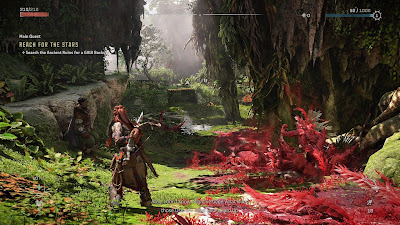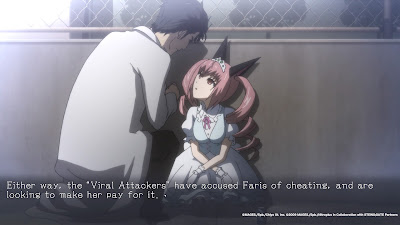Horizon Forbidden West is the sequel to Horizon Zero Dawn. The start of this game heavily references the story events from the first game. While you can get the general idea, newcomers will probably feel lost and detached. The game will be familiar to returning players so it can feel samey at times. This is a third person action adventure where Aloy has melee attacks with her spear. However, her main form of attacking will be her other weapons, such as her bow and arrow and slingshots. There are different types of ammo, dealing a different type of damage such as acid, flames and frost.
The key draw of the game is of course the combat against the machines, that usually take on the form of a dinosaur or prehistorical animal. If you don’t want to face them head on, you can also go for stealth as Aloy has a set of stealth abilities. These include the ability to make traps, cause distractions and ways to attract machines to a location. A lot of the encounters can be done via stealth, head-on attacks, or a combination of both. On higher difficulties, facing them head-on will be difficult unless you had already lowered their numbers via stealth first.
All of Aloy’s weapons and abilities can be upgraded and unlocked via a number of skill trees. Experience is earned from defeating machines, completing quests, and hunting wildlife. It can be an addictive loop although this is something we have already seen plenty of times before. Aloy herself is nimble with plenty of parkour moves. She can jump, climb, shimmy and swing with the best of them. However, the parkour system still needs some work as there are kinks where Aloy doesn’t grab a hold of something, or doesn’t reach for the thing that you were aiming for. When she falls down and you have to start again, it can be annoying. She has a glider now to help with traversal and a key piece of equipment is her focus. This is a triangular piece of machinery clipped on her eye and is an excuse to present an informative UI that highlights points of interest for the player such as showing a machine’s weak point.
Despite the improvements, there remains a few frustrating elements. No matter how much the game handholds you or have Aloy make an obvious remark on what to do or where to go after a few seconds of looking around, there are some parts where it is still not immediately obvious. There are also poorly designed boss battles where it can be annoying as you are trapped in a small area facing against a human opponent. Yet they are invulnerable so that you must do something else. This wouldn’t be so bad except that they are constantly attacking and stunning you without a care in the world. Aloy herself is also over confident in the beginnings of the game, to the point of being arrogant and rude to a lot of people that she meets. She ends up coming off as impatient since she has more knowledge but doesn’t spend the time to try and convince the other party.
There is a huge amount of variety in the design of the machines this time around. In addition to all the ones from the first game, there are plenty of new designs, a lot of which you immediately encounter in the beginning of the game. It can get overwhelming at first but also gives you back some sense of discovery and accomplishment that was evident in the first game. The platicky look of the characters are gone. While it’s still not the most amazing facial designs ever, it is much more natural. The graphics remain stellar and impressive. It also includes a lot of accessibility options so that you can customize and tailor the game’s difficult and controls to your liking. The music is notable and provides the perfect amount of ambience and atmosphere to the game.
Like the first game, the story is a slow-burn. This is the main draw of the game though but it doesn’t hit the highs that you were hoping for. Given that the gameplay has remained largely the same, Forbidden West can feel overly familiar and even a bit boring as it doesn’t seem to do anything daring to push the formula forward. Everything works and mechanically, the game is fine with no significant weaknesses. Yet it is lacking that fresh feeling, especially when it is yet another open world game filled with collectibles and the same boring sidequest designs. What doesn’t help is that the game’s design encourages grinding, and it’s heavy grinding. There’s the big skill tree, and every weapon has multiple levels requiring differing types of rare drops. It’s tedious and slows down the game too much.
The story is interesting once it gets to the point where there is a big revelation. While it can originally feel cheesy, especially with the attitude and design of some of the characters, they present an interesting potential and facet to the grander scheme of things. Unfortunately, the story then basically boils down to being a gigantic fetch quest where Aloy has to explore the Forbidden West to find objects that will allow her to complete the thing that finally pushes the story forward, and to confront the villains. When the story finally picks up towards the end of the game, it means that only the final act has the meaty plot developments. This can come off as being too late. It can be unfair to constantly compare this game with the first, given that the original was focused on uncovering a big mystery, whereas this one is pushing the concept forward. Still, it felt like the developers squandered the potential and wasn’t totally satisfying.
The game is long, especially if you play a lot of the side content. The main story is only around 20 hours where it starts off slow but ramps up a bit towards the end with a few juicy tidbits. The ending teases what the future could be and that the series is definitely continuing, one way or another. After the story, you can continuing finishing the sidequests, finding all the collectibles, and exploring the vast open world. The open world is massive, containing all the staples you’d expect like forests, deserts, open water, mountains and caves. It’s just that the content is nothing special as it’s the usual open world filler.
Overall, there’s no denying that Horizon Forbidden West is an expansive, polished, and impressive game. However, it lacks the charm and sense of wonder that Zero Dawn had. A sequel should improve on everything, which this game mostly does, but also introduces enough new elements to keep the experience fresh, which is the area that it ends up lacking in. the gameplay mechanics and gameplay loop are too samey, especially considering the glut of open world games nowadays and unfortunately, unlike the first game, the story in this one wasn’t enough to hold it up. It’s still a worthwhile experience, just that expectations may have been a bit high after the first one.
-----------------------------------------------
(As an Amazon Associate I earn from qualifying purchases)



































































